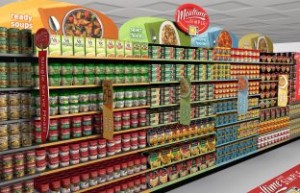
The largest expense for most retail businesses is real estate. With floor space rents increasing every year maintaining a floor space large enough for your business is an ever increasing cost. In addition to the rent you have to pay by the square foot for retail space, you also incur associated cost that increases with the size of the floor space. Insurance premiums are often based on square feet, maintenance and janitorial costs increase, and security needs become more of a challenge. To reduce the costs associated with retail space you must be able to display as much retail product as reasonably possible in as small of a space as possible.
Not Just Floor Space
The first thing to consider is floor space is not all that needs to be maximized. Wall space is actually more important in most cases. A small 20 ft. x 20 ft. retail store has 400 square feet of floor space to use. It also has 4 walls that provide 160 square feet of display space each, and can be fitted with 36 ft x 12 ft shelves providing 144 square feet of display space on each wall. Now the small area has 1072 square feet of display space that can be easily leveraged.
When planning implementation of shelving and displays you will need to check fire codes and accessibility code in your locality. Fire codes will dictate how direct of a path is needed to exits as well as materials that can be used in shelving. You need to balance the desirability of customers moving throughout the store with safety needs.
Many locations have code that requires certain amounts of space for aisles. In addition to comfort and convenience of all shoppers, wheelchair or power scooter access is not only desirable, oftentimes it is mandated. While increasing space by vertical shelving remember that going too high limits product visibility and increases needs for assistance for many shoppers. Your insurance carrier will often have specific guidelines on how high shelving can be and what items can be stacked in higher shelves.
Constructing Displays
Using wall space and shelving can provide additional space and visibility to display merchandise. You need to be careful to use it in an aesthetically pleasing and safe manner. Simply putting nails in a wall to hang things from is fine for your garage but not for a retail store. Using slatwall panels you can make easily adjustable displays that are inexpensive and professional looking.
For self-supported shelving, build or purchase shelving keeping in mind the weight it needs to support and always anchor it to the floor so it cannot be tipped over by somebody climbing, leaning, or falling against it. This also protects against the shelves becoming top heavy due to uneven weight distribution. Once again, many localities have building codes that will dictate this set up along with guidance from your insurance company.
Some product line vendors will provide displays or display shelves for their products. While these are designed for retail use and should be safe and adequate, installation and anchoring are ultimately your responsibility. When using these, make sure they do not violate fire codes and or pose a tip over risk.
Related posts:







Wow I didn’t realize that so much thought went into the layout of a retail store.